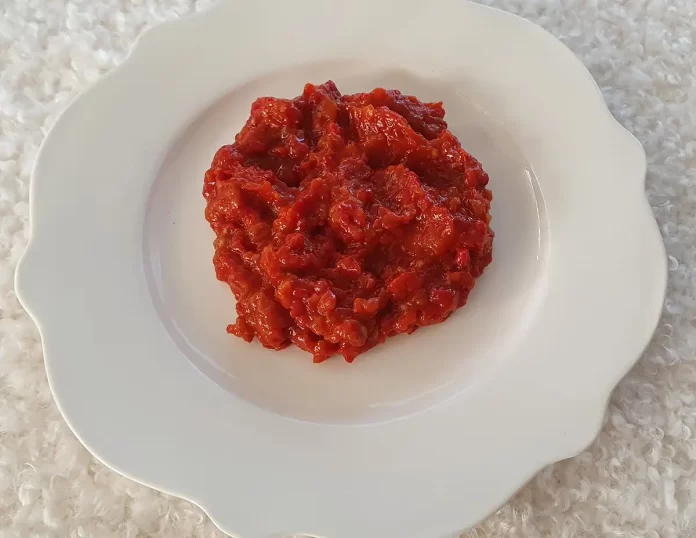This original Lutenitsa Bulgaria recipe is a popular and traditional Bulgarian spread with red peppers, tomatoes and eggplant. Full of flavors, it is added to meat, sausages, cheeses or spread on bread. This delightful dip is a staple in most households and although it is synonymous with Bulgaria, it is also popular in the Balkans. Meet this exciting and aromatic Bulgarian lutenitsa.
What is Lutenica?
Lutenitsa is a delicious spicy-sweet spread.

It is prepared with roasted red peppers, carrots, onions, tomatoes, eggplant and spices. However, there are many ways to prepare this delicious dip or dish and every family has their own secret recipe.
The name lutenitsa comes from the Bulgarian word lyut, which means hot. As a result, you will find some versions that are spicy and others mild based on the peppers and spices used.
In addition, there are differences in the consistency of the lutenica, ranging from a smooth sauce to a rough one with small pieces of vegetables.
This original recipe for lutenitsa is not complicated and is easy to prepare at home. The taste is sensational, and the rich spread of roasted vegetables will become a new favorite at home.
History of lutenitsa Bulgaria – the original lutenitsa recipe

Homemade lutenitsa is a traditional Bulgarian salty delicacy and a culinary symbol of Bulgarian cuisine. The preparation and tradition of an original Lutenitsa recipe is passed down from generation to generation and is often associated with the end of summer.
The history of the Bulgarian lutenitsa is rather murky. One story traces its origin to the 1930s, when Bulgaria began intensive production of tomatoes and red peppers for domestic consumption and export.
If you prefer to watch while you cook, just play the video below for an original recipe for lutenitsa.
During World War II, the lute was produced in large quantities and quickly gained popularity. In the 1950s, lutenitsa was mass-produced and the Bulgarian government defined a standardized recipe.
Nilo provided that the lutenitsa should be made only with tomato and pepper puree, onion, salt, sugar and oil.
Later, after the fall of the Iron Curtain, many variants of lutenitsa flooded the market. Added ingredients such as carrots and eggplant are popular additions to the lutenitsa recipe.
Today you will find distant cousins like Ajvar, Pindjur or Zacuscă in other Balkan countries.
This simple lutenitsa Bulgarian recipe combines red peppers, tomatoes, carrots, eggplant, onions and garlic with a little sugar, salt and pepper.
Original recipe for lutenitsa
Preparing lutenitsa at home is actually quite simple. Although the recipe is not difficult to follow, it takes time to cook and peel the vegetables.
Once all the ingredients are ready, just mix everything together. Use a food processor or electric blender to make your own lutenica recipe. Once your delicious lutenitsa is ready, fill jars for storage. Do not forget to prepare well-sterilized jars for a longer shelf.
- 16 medium red peppers
- 8-9 medium ripe tomatoes
- 1 large eggplant
- 1 large onion
- 2 carrots
- Vegetable oil
- Sugar
- Salt
Instructions for an original Lutenitsa Bulgaria recipe:
- Pre-wash all the vegetables.
Arrange the red peppers lengthwise on a baking sheet. - Preheat the oven to 200°C and roast the peppers, turning them every time large brown blisters form on each red pepper.
- The peppers are baked for about 1 hour.
- Remove the red peppers from the oven and set aside. While still warm, cover with plastic wrap to make the skin easier to remove. Let the red peppers sit for 24 hours.
- With a small, sharp knife, make a small cross cut in the top of each tomato and arrange them in a baking dish. This will make it easier to peel the tomatoes later.
- Make a thin cut on each side of the eggplant and place it on top of the tomatoes. Place the baking tray in the oven and bake at 200°C for about 1 hour. Leave to cool.
- Peel the peppers and remove the stems. Use your fingers to peel the tomatoes and eggplant.
- In a medium to large saucepan, cook the carrots and whole onions for about 20 minutes. Drain the water.
- Place all the red peppers in a blender and blend until smooth. Transfer to a large saucepan.
- Combine the carrots, onion and eggplant together and blend well in a blender. Transfer the mixture to the large pot with the red pepper mixture.
- Mix all the tomatoes together and add the tomatoes to the large bowl.
- Over medium-low heat, stir the mixture with a wooden spoon. Add the oil and spices and cook uncovered for about 2 hours. Stir frequently to avoid sticking or burning.
- To check the doneness of the lutenica, use a wooden spoon and scrape the bottom of the pan and move the lutenica from side to side. If it’s a little thicker and doesn’t run back, it’s done.
- Pour the mixture into clean and sterilized jars and put the lid on tightly.
- Store the lutenica in the refrigerator for 2 weeks, and if the jars are well sterilized, the lutenica can be stored for several months.
You can also try to make a topping for moussaka
